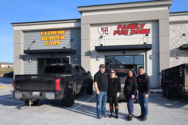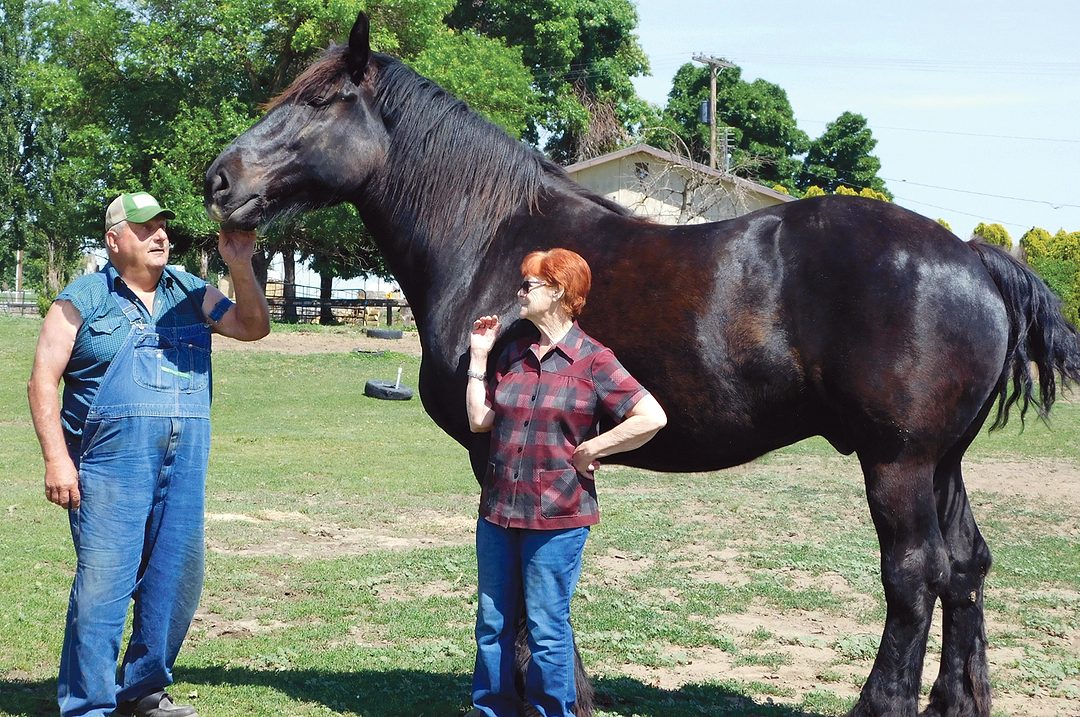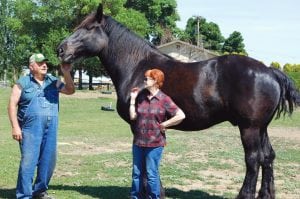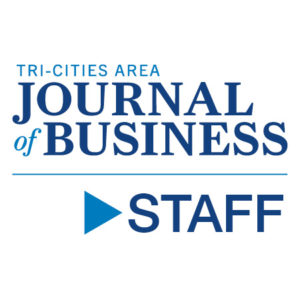
Home » Andrewjeskies’ Percherons have wowed parade goers for decades
Andrewjeskies’ Percherons have wowed parade goers for decades

June 15, 2016
Encounter the Andrewjeski family and their Percherons draft horses at a fair, parade or show and they’ll gladly answer your questions.
But please, please don’t ask them the one they hear the most.
“Does it hurt when they step on your foot?” Helenka Vanderbilt of Connell said.
With an average weight of anywhere from 2,100 to 2,900 pounds, the answer is an emphatic “Yes.”
Vanderbilt is one of Bob and Lois Andrewjeskies’ four daughters and the only one currently involved with the care and use of the family’s five draft horses. She grew up with the family’s massive equines, although animals have come and gone over the years.
“I began driving a team when I was 7 years old— I’m 43 now,” she said.
Her parents bought their first draft horses, two half-Percherons, Dolly and Daphane, in 1948.
“We’d gone to a sale at Quincy Livestock, which was owned by the Easterdays, and Bob bought the two big white mares. Later he bought a black registered Percheron stallion and showed him at draft horse shows in Monroe and Sandpoint, where he took champion. That’s all it took,” said Lois Andrewjeski, now 76.
Those ribbons instantly had Bob Andrewjeski hooked on draft horses — more specifically, black Percherons.
Bob Andrewjeski grew up in Flagler, Colo., where his grandfather farmed with horses, using a variety of breeds.
“Many of them were a cross between a wild pony off the range and a draft horse. They weren’t well trained — they were pretty wild,” said Bob Andrewjeski, 70. “As long as your lead horses were under control the rest just had to go along because they were all chained together.”

And Andrewjeski’s father worked his land using horsepower, quite literally.
“He hated it. As soon as he could switch to tractors, he did,” Bob Andrewjeski said.
Despite his dislike for using the horses to work the farms, Andrewjeski’s father was a very good horse trainer, he added.
That knack for handling horses was passed down through the generations. Working on the family farm/ranch in Colorado, Bob Andrewjeski grew up riding horses.
“You had to. It was the only way to work the cattle or get from one place to the other,” he said.
Bob Andrewjeski’s family left Colorado and moved to the Mid-Columbia in 1954. It would be seven years before Bob Andrewjeski got another horse — a half Percheron named Sadie that he’d bought for $100 from a man in Wallula.
“I earned that money stacking hay. I was 12 or 13 years old at the time,” Bob Andrewjeski said.
Sadie was Andrewjeski’s riding horse and he spent countless hours on her exploring the Mid-Columbia.
“We went all over the place,” Bob Andrewjeski said.
Bob Andrewjeski’s wife, Lois, grew up in Ponca City, Okla., and moved with her parents to Anacortes when she was 18.
“I hated Anacortes. We moved there in the fall and I think it rained everyday until June,” she said.
Eventually she ended up in the Mid-Columbia, met Bob Andrewjeski and they married in 1968. That same year the Andrewjeskis moved to Eltopia and started farming and ranching a plot of land they still call home. There they’ve farmed, raised alfalfa, potatoes and “most everything you can grow around here,” as well as raised cattle and horses, he said.
And in the winter, Bob Andrewjeski kept busy training horses.
“I’d bring in 15 or 20 head, mainly those other people owned, but didn’t want to train. It brought in some money when we couldn’t farm in the winter months,” he said.
He kept up that routine until about five years ago, when he had his first two knee replacements.
“Those didn’t take and he had to have another set put in,” Lois Andrewjeski said.
That slowed the couple down a bit and now they’re semi-retired. Most of their land, except for some pasture for the Andrewjeskies’ beloved Percherons and their cattle, is leased out.
While raising their daughters, farming, cattle ranching and training horses for other horsemen, the Andrewjeskies traveled the Northwest and beyond, showing their Percherons and participating in fairs and parades.
They showed their impressive equines in Redmond, Ore., Sandpoint, Idaho, Deerlodge, Mont. and Monroe, Wash.
“We did that for quite a few years and only stopped about 12 years ago,” Lois Andrewjeski said.
They also hitched up the team for fairs and parades in Yakima, Coeur d’Alene, Spokane and other events closer to home.
Now they’ve cut back on the number of horses they own, down to just five after having as many as 20 head.
“You needed that many when you had a six-horse hitch and some were pregnant mares or young horses,” Bob Andrewjeski said. “You can’t begin training them until they are 3 years old. And you really don’t want to take a stallion out where there’s crowds of kids, like parades.”
All the Andrewjeskies’ children and grandchildren grew up around the massive horses, which Helenka Vanderbilt describes as gentle giants.
“We rode them, drove them, just generally climbed all over them,” Vanderbilt said.
About 13 years ago the Benton Franklin Fair Board spent $40,000 on the stagecoach the Andrewjeskies’ horses pull in parades.
“We’re still using it but now we just use two horses, not six or four to pull it. It’s easier for Helenka to drive with just two,” Bob Andrewjeski said.
Andrewjeski said his primary wheeler horse, Captain, who is hitched closest to the coach, had a habit of kicking the stagecoach when he was young.
“He could actually kick high enough to kick the board under my feet as I was driving. Every time he did it I could see those fair board people cringe as they heard that wood go ‘crack.’ The board was never replaced, you can still see the cracks he made,” Andrewjeski said, laughing.
At 19 years old, Captain is now retired from pulling the stagecoach and he spends most days swishing his tail under a shade tree.
“I could still use him in parades to just walk along. But his knees, like mine, are pretty stiff for anything else. He’s not a show horse anymore but he has a place here,” Bob Andrewjeski said, thumping his heart.
As spring rolls around each year, the couple considers fully retiring. And then they sign the contracts to appear at various fairs and rodeos.
“We enjoy it, the family comes to help get the horses ready and we all go to the fairs and spend time together. The horses bring us together,” Lois Andrewjeski said.
Bob Andrewjeski agreed, saying the most fun he’s ever had has been watching their seven grandchildren working and driving the big, black horses.
Local News Agriculture
KEYWORDS june 2016





